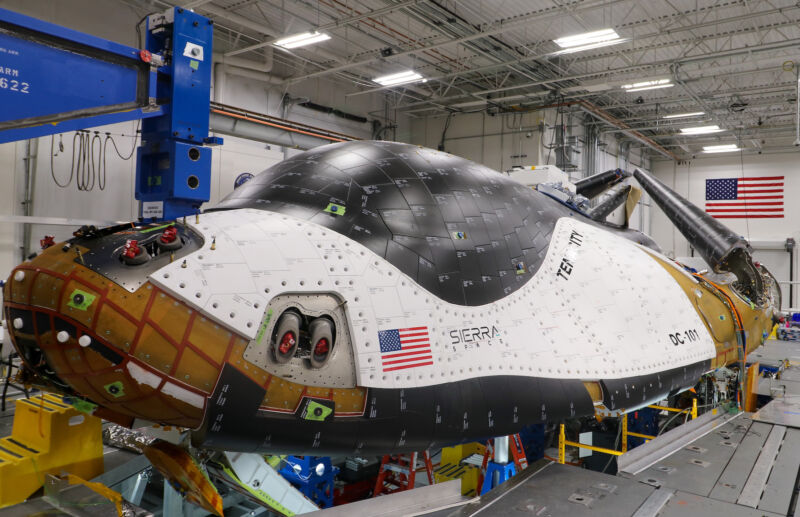
Stephen Clark/Ars Technica
LOUISVILLE, Colorado—The first Dream Chaser spaceplane built to go into orbit is starting to look the part. Its foldable wings and fuselage are covered in custom-fitted ceramic tiles to shield the spacecraft’s composite structure from the scorching heat of atmospheric reentry as it flies back to Earth. It has its landing gear, and technicians buzz around the vehicle to add the finishing touches before it leaves the factory.
Inside the spacecraft, workers are installing the final ducts for the environmental control system, which will make the pressurized compartment within Dream Chaser livable for astronauts at the International Space Station. The Dream Chaser’s job, at least for now, is to ferry cargo to and from the research complex orbiting some 240 miles (385 kilometers) above Earth. It will launch on top of a conventional rocket, maneuver in space like a satellite, and then land on a runway.
Across the hall from the production floor, Sierra Space has set up a mission control room, where engineers will monitor and command the spacecraft when it’s in orbit. Down the hall, a mock-up is in place for astronauts to train on how to enter the Dream Chaser and pack and unpack cargo while it’s docked at the station.
This was the scene Monday as Ars visited Sierra Space in Louisville, Colorado, a suburb northwest of Denver. Several hundred workers took a short break for congratulatory remarks from leaders at Sierra Space, a subsidiary spun off of privately held Sierra Nevada Corp. in 2021. Within a few weeks, the Dream Chaser spaceplane, named “Tenacity” and carrying the serial number DC-101, will be out the door on the way to a NASA facility in Ohio for a battery of tests to prove it can survive the rigors of spaceflight.
Assembly complete
There are still some covers and tiles missing from the spacecraft. Tom Vice, Sierra Space’s CEO and a former executive at Northrop Grumman, said engineers have intentionally left some of those components off Dream Chaser for its next round of tests.
“We’re almost done with everything,” said Angie Wise, Sierra Space’s chief safety officer. “We’re finishing all the closeout panels. We’re essentially getting it ready for shipping. We’ve checked out the landing gear. We’re going to put everything back in, stow it, and then move it onto the (transport) fixture and get it out of here.”
Dream Chaser is undeniably a neat spaceship, and its story is remarkable. It taps into a vision for the future of spaceflight with roots at the dawn of the Space Age, combining the elements of rockets with aircraft. NASA has been studying or flying spaceplanes almost continuously since the agency’s founding, and the military has been a big fan of spaceplanes for close to 60 years. Virgin Galactic operates a suborbital spaceplane for space tourists and research flights.
So Sierra Space isn’t by itself in the spaceplane arena. Nevertheless, the company stands alone in its persistence in an industry that has recently prioritized capsule-shaped spacecraft or outside-the-box designs like SpaceX’s reusable Starship rocket. Dream Chaser will be the first commercial spaceplane capable of orbital flight.
“We are introducing the world’s first revolutionary space line,” Vice said. “This will change how we travel from Earth to space and back again.”

Stephen Clark/Ars Technica
Sierra Space says its Dream Chaser will provide its cargo a gentle ride back to Earth at no more than 1.5 Gs. This is useful for animal specimens and other sensitive payloads. Dream Chaser will also deliver payloads closer to the labs that analyze experiment results.
“Plunging into the ocean is awful,” Vice said. “Landing on a runway is really nice.”








